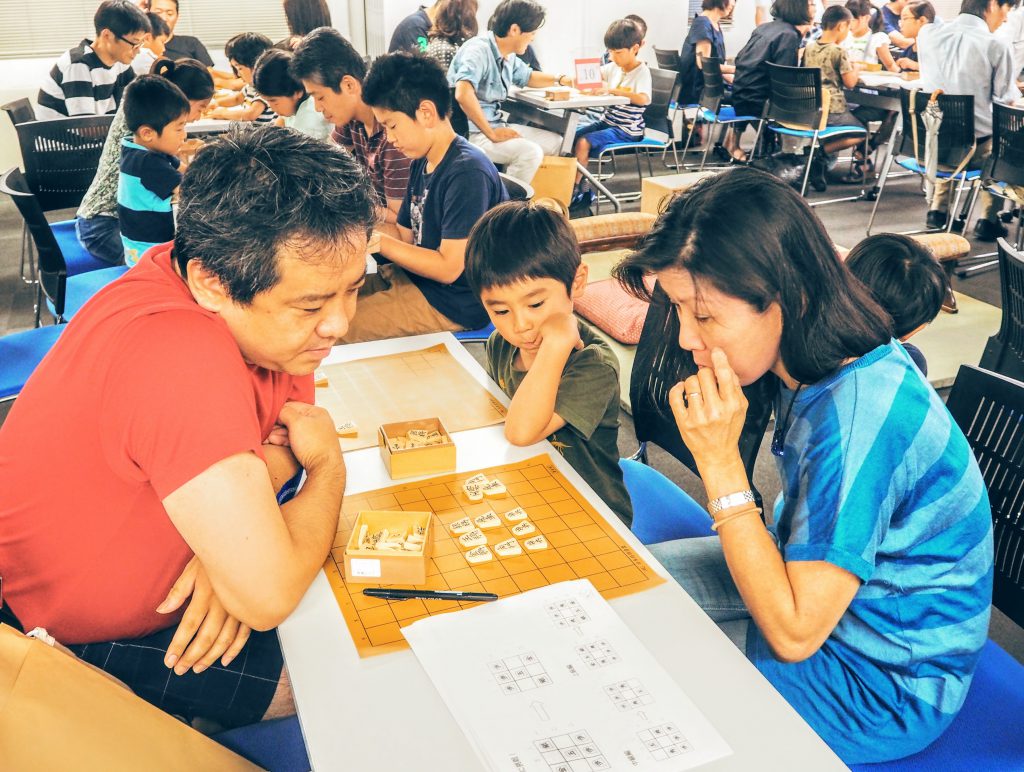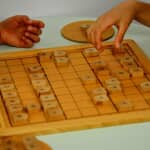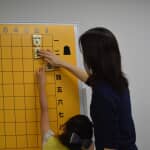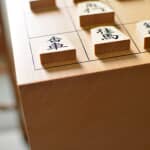Shogi 24 January 2017
A Piece of Cake! Games You Can Learn Piece Moves–Shogi Puzzle–
We, I-tsu-tsu Co., Ltd., have held events named “Let’s take a glance at Shogi world!” aiming to make Shogi popular around Japan.
Our present theme for our events is how to make Shogi familiar lowering the hurdle to start playing Hon-Shogi, or Standard Shogi as opposed to other shogi variants. We are working on this theme day in, day out.
Speaking of Shogi, there are many things to learn before you become to enjoy Hon-Shogi: movements of eight kinds of pieces, prohibited rules (Kinji-te, in Shogi term), and such like. Even starting the first step, you need to remember a lot. We have been struggling on making the path to understand Shogi rules more interesting. Posting several articles, we have shared our ideas to integrate Shogi into our daily lives and make it common practice.
Nevertheless, when people do nothing but memorize things, probably they lose sight of the original purpose of Shogi. Especially, children like playing a game more than memorizing its precise rules.
I would like to introduce some games whose motto is “simple” and “interesting”. We designed games using Shogi rules so as to support you to enjoy a long way to Hon-Shogi.

Some Shogi puzzles listed below are for somebody who have learned the movements of pieces. With a little knowledge of movements, even children can easily enjoy those games. Let’s get Shogi board and pieces, and have fun with them.
For those, children on particular, who don’t remember movements of pieces completely, we invent a smart and practical mat, instructing their movements. You can get it via our online shop.
In our previous article, we introduced a game to remember “Tsumi” or checkmate, and “Kiki” or moving ability. That game is named “Tag chasing a King”. That is also a simple game that children can enjoy with their parents. You must try it, too!
Puzzle 1: Let’s rearrange the positions of pieces.
Move pieces as much as you want until your pieces make the same figure as described in the picture.

Advice: In this puzzle any movements won’t mess up the game, so just move! When you get hang of this, try to finish with the least number of movements. The minimum is seven movements.
Puzzle 2: A sheltered princess in I-Tsu-Tsu style.
Move those pieces below, and take a piece at the starting point to the goal.

Advice: A king can move towards any directions, let’s provide the path for a king to move, by manipulating the others.
Puzzle 3: Drop pieces according to the moving rules.
Let’s drop your pieces with their moving rules.
Be sure not to interrupt the other’s movements each other.
The answer is that all pieces are on their positions in which each piece maintains its original ability of moving to a specific square; we call this ability “Kiki”.

Advice: Kyousha or Lance can move as many squares as desired, but only forward. Taking account of this rule, what would you do?
How were our puzzles? Did you have fun with them?
We have several reasons to introduce those puzzles, as I will describe later, boiling down in three points.
Easy!
We regard Shogi as a game that around five-year-old children could start to play, and tell so to people. In addition, the charm of the puzzle games I mentioned above is easy to play for small children.
Previously, at an event in Hiroshima, a four-year child tried these puzzles. Although they were a bit difficult for her, she finally solved all after much hard work. When her piece got stuck, she tried to figure out the way to solve the situation. And then, she carefully avoided repeating the same mistakes. I was amazed to see that all children were concentrating very much. They said they had had really fun time.
Moreover, the other day during a different event, many children and parents tried to solve these puzzles together. They enjoyed working together, saying “Should we move this piece in this way, or that way?” They looked really happy to be engaged in together.

We do really hope everyone who got to find Shogi to be fun at our events would continue to enjoy Shogi and never lose interests in Shogi. We think our presented puzzles could be of help to learn and remember piece-movements and the rules. Then, enjoying the whole process, you would quite naturally become to sense the pleasure of Hon-Shogi. These are our sincere hopes.
Easy and fun to remember the rules!
It is also the highlight of our puzzles that you can remember the movements of pieces just like playing games.
At the very first stage of remembering piece-movements, you may well confuse the movement of Kin or Gold with that of Gin or Silver. You may get confused and not be sure which is which. Sometimes, you might move Gin backward. Beginners, children on particular, tend to make mistakes in that way. In that sense, with our puzzles, you could have various opportunities to move pieces in many ways. That would be a great experience to move pieces in practical ways. Also, you could learn the concept of the ability which each piece possesses.
You will be able to understand the basic logic of “Kiki” which means the ability of each piece: when your opponent’s piece comes to a certain square, you can take it. You need to have enough understanding of this concept to play Hon-Shogi. Those abilities of all pieces are difficult to memorize, but with our puzzles you could learn each movement visually.
Long-lasting!
The most important purpose of our puzzles is to make the path to Hon-Shogi shorter, so they are just simple and fun to play with.
Usually, children tend to be categorized into two groups:
- children who move pieces without hesitation,
- and children who think the way to move in their minds first, and then move the piece in practice.
I am probably supposed to say that the second group is better, so try to be in the second group. But, actually I won’t say so, but I would like to say both type could be fine! Especially, at the beginning, you can move pieces without any hesitation. Moving pieces continuously, you and your children stop and think together when pieces lose the way to go.
It might be issue of personality, so both types are just fine. Let’s keep enjoying Shogi.
When your children seem to get the knack of the rules, you could ask them to make some practice exercise. “Mom, try to solve my practice!” Hearing lovely voices, you and your children surely will have some quality time.
Practice Exercise
There are some more practices. Why not give a try with your children?
Make the same figure as the original.

Advice: When you are stuck with all pieces, try to change your way to move them. Think about the final position of Gin.
Guide the piece at the starting position to the goal within 11 squares.

Advice: Previous practice, the guided piece was a Gyoku or King, but now it is a Hishya or Rook. It’s going to be a bit difficult, but thinking to provide longitudinal and horizontal paths would help you!
Drop pieces, considering their abilities to move.

Advice: Gin can’t move sideways, but Kin can. Taking this difference into consideration, let’s try to drop them.
Drop two pieces in the way to make all movements are available.

Advice: Positioning Kin at the center will give you the most availabilities.
We have prepared more practices, making full use of the characteristics of each piece movement, and also something a bit more difficult.



